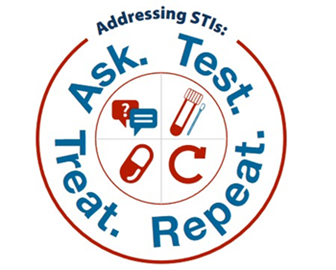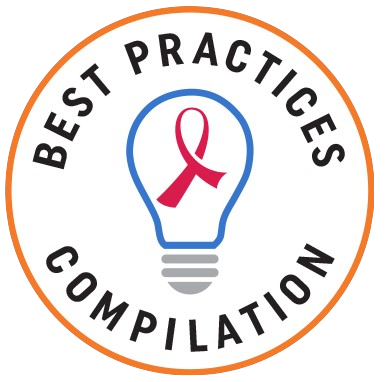In response to rising rates of bacterial sexually transmitted infections (STIs) in the United States, nine sites implemented four evidence-based interventions, collectively known as Addressing STIs: Ask.Test.Treat.Repeat., as part of the Ryan White HIV/AIDS Program (RWHAP) Part F Special Projects of National Significance (SPNS) Improving Sexually Transmitted Infection Screening and Treatment among People with or at Risk for HIV initiative. The four intervention components are audio computer-assisted self-interview (ACASI) sexual history taking, patient self-collection of urogenital and extragenital site chlamydia/gonorrhea nucleic acid amplification test specimens, sexual and gender minority welcoming indicators, and provider training, with the overall goal to routinize STI screening, testing, and treatment in primary care. The interventions increased routine STI screening and testing of bacterial STIs based on reported behavioral risk.
Washington, DC
FL
LA
Despite increases in the incidence of Chlamydia trachomatis (CT), Neisseria gonorrhoeae (GC), and syphilis each year since 2014, routine assessment (screening) of patients with HIV for STI risk and testing (urogenital and/or extragenital sites) is not consistently performed in clinics.1 Although annual testing of CT/GC and syphilis is recommended for all people with HIV, the Centers for Disease Control and Prevention (CDC) recommends that patients reporting having had two or more sexual partners, using alcohol or other drugs with sex, and those engaging in commodity sex, be screened and tested every three to six months.2,3 However, many people are not routinely screened and tested due to multifaceted barriers. These include feeling stigmatized when receiving care or sharing information about their sexual histories, health care providers’ discomfort with discussing sexual behaviors, limited time in medical visits, and limited STI testing and treatment knowledge.
Clinics integrated the use of ACASIs to conduct comprehensive and consistent sexual health history and screening during every routine clinic visit (including lab visits) and some acute visits. Patients used tablets to complete the ACASI sexual health history during their appointments, but prior to meeting with their providers. The sexual history includes 32 questions with sub-questions assessing gender identity, sexual identity, assigned sex at birth, STI-related review of symptoms, and occurrence of specific sexual behaviors and related factors since the patient’s last clinic visit. Eight items assess the STI-related risk behaviors, based on CDC recommendations. Included at the end of the sexual history are questions on preference for self-collection or provider-collected CT/GC nucleic acid amplification test (NAAT) specimens for each anatomical site if needed. Upon completion, the ACASI-based sexual history creates a summary of needed tests based on answers provided in the sexual history, along with the patient’s preference for self-collection or provider collection of specimens. Clinics added standing orders for the STI-related tests recommended by the completed sexual history.
If indicated by the ACASI sexual history, staff provide patients with the necessary supplies and instructions on self-swabbing for pharyngeal, rectal, or vaginal CT/GC NAAT specimens. These self-testing instructions include a verbal description and a visual demonstration; patients are also given a poster illustrating self-testing. Describing the need for and steps of STI self-testing in a relatable and non-judgmental way helped patients to see STI screening as normal and part of ongoing care.
Twelve indicators were identified on how to make clinical spaces welcoming to the LGBTQ+ community and included:
- Respectful treatment by clinical staff
- Gender-neutral bathrooms
- LGBTQ+-inclusive waiting room materials
- LGBTQ+-inclusive educational materials
- Posted LGBTQ+-non-discrimination policy
- Registration selected pronoun question
- LGBTQ+ supportive organization flier(s)
- LGBTQ+ flag
- Transgender flag
- LGBTQ+ Awareness Days/events promotion
- LGBTQ+ individual participation on community advisory boards
- Posted signs declaring the clinical space a "judgment-free zone"
“Clinic staff work to reduce stigma by setting aside extra time for new clients to build rapport and talk to the client about reasons why they are being asked certain personal questions.”
The National Network of STD Clinical Prevention Training Centers conducted virtual provider trainings on these four topics (one every three months) in the following order:
- Epidemiology, Diagnosis, and Treatment
- Culturally Responsive Care to Reduce Stigma
- Taking a Comprehensive Sexual History
- Success Stories in Improving STI Care
The interventions increased routine STI screening and increased testing of bacterial STIs based on reported behavioral risk from the baseline needs assessment conducted in 2018 and 2019 to the intervention period which ended in August 2021. Overall, more patients were screened and treated for STIs, not only those who reported symptoms. Of 255 cases of CT, GC, and syphilis infections, only 14% of patients reported related symptoms when screened and tested, with 86% not reporting symptoms.
| Category | Information |
|---|---|
| Evaluation data |
|
| Measures |
|
| Results |
|
Source: Nelson JA, Zha P, Halawani M, Jones V. Evidence-based interventions implemented into HIV primary care clinics to make sexually transmitted infection screening and testing routine: Outcomes of a multi-site study. AIDS Patient Care STDS. 2022 Nov;36(S2):92-103.
Needs assessment. As part of the SPNS funding, researchers from the Rutgers School of Nursing conducted a needs assessment to identify barriers to consistent and comprehensive sexual health screening. The four interventions were selected based on these identified needs.
Provider training. Provider training was provided by the National Network of STD Clinical Prevention Training Centers or by the Ryan White HIV/AIDS Program Part F AIDS Education and Training Center Program regional teams.
Staffing. The staffing model for the intervention at each clinic includes:
- 1.0 FTE clinical prescriber (MD, DO, NP, PA) to order labs, diagnose, and provide treatment (with a standing order for STI specific testing orders when prescriber is not available).
- 2.0 FTE clinical non-prescriber (RN, SW, MA) to provide screening, testing, treatment, and follow-up.
- A staff member on call to assist patients who may be novice technology users with taking the survey on a tablet or laptop.
Development of materials to support replication. As part of the SPNS funding, Rutgers School of Nursing developed a Sexual History Taking Toolkit with adaptable tools to help clinics improve screening, testing, and treatment of common bacterial STIs among people with HIV or at risk for HIV.

Delivery of the ACASI-based sexual history to every patient each day in the clinic can be taxing for small clinical teams. In addition, clinics were not able to upload the ACASI-based results into EMRs. The other three interventions (provider training, patient self-collection of CT/GC specimens, and LGBTQ+ welcoming indicators) have been easier to sustain.
- Patients who could not make it in person to the clinic for labs or for whom the on-site clinic lab was not available (due to COVID-19 related closures) were sent to local commercial lab collection sites. At these commercial sites (in all three jurisdictions), extragenital site CT/GC NAAT specimen collection was not allowed. Patient self-collection of CT/GC NAAT has not been approved by the FDA for extragenital site specimens. Therefore, only labs that have conducted a validation study of patient- versus provider-collected extragenital site specimens to verify noninferiority of patient-collected specimens were able to test patient-collected specimens. This was identified as a large barrier to normalizing routine screening and testing during the COVID-19 pandemic, since much of primary care was done using telehealth technologies.
- If clinics want to use the ACASI software, an ACASI software developer is needed, but other options for self-administered sexual history taking include patient portals or other Health Insurance Portability and Accountability Act (HIPAA)-compliant survey systems. Sexual history can also be added as a patient portal component of EMRs, but customization by the EMR vendor may be required.
- The ACASI-administered sexual history allowed patients to be screened and tested at clinic lab visits when not seeing a provider in person (such as with increased telehealth visits).
- Conversations between patients and providers during the self-testing instruction discussions afforded an opportunity to provide more health education on STIs. The ability to self-test helps patients take a more active role in their sexual health.
Implementation Resources
- Addressing STIs: Ask. Test. Treat. Repeat. Fact Sheet (2024)
- Integrating HIV Innovative Practice (IHIP) Addressing STIs: Ask. Test. Treat. Repeat. Intervention Implementation Guide (2023)
- Improving Sexually Transmitted Infection Screening and Treatment among People with or at Risk for HIV
- Starter Toolkit
Presentations
Other Resources
- Nelson JA, Zha P, Halawani M, Jones V. Evidence-based interventions implemented into HIV primary care clinics to make sexually transmitted infection screening and testing routine: Outcomes of a multi-site study. AIDS Patient Care STDS. 2022 Nov;36(S2):92-103. doi: 10.1089/apc.2022.0131. PMID: 36178405.
- Nelson J, Jones V. Project Introduction. AIDS Patient Care STDS. 2022;36(S2):87-91. doi:10.1089/apc.2022.0101 (includes full screening questions)
- Cullinen K, Hill M, Anderson T, et al. Improving sexually transmitted infection screening, testing, and treatment among people with HIV: A mixed method needs assessment to inform a multi-site, multi-level intervention and evaluation plan. PLoS One. 2021;16(12):e0261824. 2021 Dec 28. doi:10.1371/journal.pone.0261824
- Centers for Disease Control and Prevention. Sexually Transmitted Disease Surveillance, 2019. U.S. Department of Health and Human Services: Atlanta; 2021.
- Workowski KA, Bolan GA; Centers for Disease Control and Prevention. Sexually transmitted diseases treatment guidelines, 2015. MMWR Recomm Rep 2015;64(RR-03):1–137. Erratum in: MMWR Recomm Rep 2015;64(33):924.
- Workowski KA, Bachmann LH, Chan PA, et al. Sexually transmitted infections treatment guidelines, 2021. MMWR Recomm Rep 2021;70(4):1–187; doi: 10.15585/mmwr. rr7004a1.

